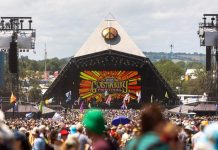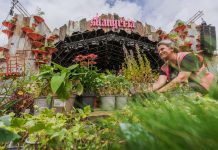UK: Although it makes up a relatively small portion of the company’s remit, Architects of Air’s presence at festivals provides punters with a reprieve from 360 degrees of bodies and noise. Their ‘luminaria’ are sprawling inflatable structures constructed of custom-made coloured PVC, comprising approximately 10,000 metres of seams, 20,000 metres of masking tape, 5,000 square metres of plastic, and 200 litres of glue. All in all, it takes around 5,000 hours of work to construct a single one with a team of ten people.
But the work clearly pays off. Instead of buying DMT from a guy named Mortimer who wears a dressing gown outside in order to journey to an inter-dimensional Zen cave composed of liquid light, you can wander through a luminarium for free. Conversation with the Godhead not included.
Festival Insights spoke with Alan Parkinson – Architects of Air’s Artistic Director – to discuss the inspirations behind and the festival-specific challenges facing their luminaria.
Festival Insights: What were the architectural and philosophical concepts that inspired the design of these colossal vessels of light?
Alan Parkinson: Architecturally my inspirations came originally from Islamic architecture and the early periods of cathedral architecture. Sometimes the two overlap – you can find similarities of ‘feel’ between the vaulted undercroft of Canterbury Cathedral and the Cordoba Mezquita, for example. Both geometric solids and natural forms also inspire me.

Philosophically my motivation was to share a sense of wonder of the beauty of light. Our luminarium structures offer a particularly immediate way to deliver that experience – and to do so in such a manner that is accessible to the broader public.
FI: Besides the physical space required, are there any unique challenges that music festivals present to the running of the luminaria? It seems you’re attempting to cultivate a very tranquil, isolated atmosphere inside so I assume background noise and wayward drunks are potential issues.
AP: I did have reservations about the suitability of music festivals and the risk to the ambiance. But our experience has contradicted those reservations. There’s something otherworldly about the experience inside the structure that somehow seems to cut the visitor off from the outside, despite proximity to sound stages.
The staffing of the structure is key to the management of the visitor experience and music festival can require a bit more solid gate-keeping. The occasional drunk festival-goer rarely makes it past the entrance as the staff are quite vigilant about the condition of the people who enter.
FI: Budapest’s Sziget Festival seems to be the largest musical event you work with, and you’ve done so for a number of years. Is there any particular characteristic of Sziget that has led to this partnership over other music festivals?
AP: The major element has been that the festival has consistently entrusted the management of our part of the festival to a very competent person who knows his public and who understands the particularity of the luminarium. His attention to detail and his willingness to work really hard makes it a success.

FI: Do you feel that the demand is rising for unique installations such as yours in the music festival market?
AP: Demand has been steadily rising across our markets and so we are seeing a rise in our activity – but the music festival market is pretty static for us. I’m not sure why that is as there have been some festivals emerging that are more intimate with a family atmosphere that would appear to be a perfect context for our work.
FI: That said, what are Architects of Air’s plans for 2015?
AP: In 2015 we’ll have 6 structures touring. The year kicks off in Australia with MONA in Hobart (including a music collaboration with Jim Moginie ex Midnight Oil) followed by WOMADelaide. We’ve got a tour building in the US which will probably include the Los Angeles Music Center. In Europe we’re planning a return to Sziget with a structure that is new to Budapest.
Header photo credit: Ian Allan




